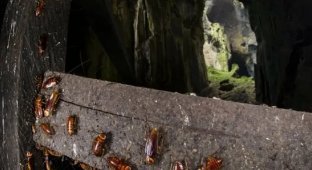The Chinese breed cockroaches. What do they do with them later? (8 photos)
It turns out that there are full-fledged cockroach farms in China. We are actively fighting these nasty insects, and the Chinese are diligently breeding them! And they even get a good salary for it. 
In recent years, cockroach farms have been considered one of the fastest growing industries in China. Let's see why they do it and how they use cockroaches.
There are currently 133 cockroach farms operating in China. An average farm can breed up to 1 billion cockroaches per year. And the record-breaking farm produces more than 6 billion individuals.
A large cockroach farm is set up like this. The area of the building is about the size of two football fields. Inside, there are rows of shelves with special containers with food and water. The building is warm, humid, and dark - ideal conditions for cockroaches.
Cockroaches are sold for up to $44 per kilogram. Farm owners make huge profits.
The building is hermetically sealed, people - except for employees - are not allowed in. And the cockroaches cannot escape. These cockroaches will never see the light of day. 
Not all residents are happy to be neighbors with cockroach farms. That's why their owners try not to actively advertise what exactly they grow
They are collected simply - with the help of devices similar to a vacuum cleaner. It is impossible to hide and crawl into a crack, like in our kitchen, on the farm. Then they are drowned in a vat of boiling water and then dried in the sun.
The complex is arranged in the format of a smart farm. A special system based on artificial intelligence continuously measures indicators for more than 80 parameters. In addition to standard temperature and humidity, it even tracks genetic mutations in cockroaches. And it signals about mutations that have a negative effect on growth and reproduction.
One of the farms in eastern China had a problem with tightness due to carelessness of the staff. And this led to 2 million cockroaches escaping from the farm and flooding the nearest settlements. There was a scandal that was resolved with difficulty.
All this is necessary so that the cockroaches reproduce as quickly as possible (as if they ever had problems with this?). 
So, here's what these cockroaches are for:
Fish and livestock feed
A fairly cheap and, at the same time, protein-rich feed that fish readily consume. It is also suitable for livestock, since plant food does not cover the need for protein. 
They are also used for other pets. Reptiles eat cockroaches with pleasure. 
China now exports such food to the United States for about 1 billion dollars a year.
Medicine and health
Well, let it be on the conscience of the Chinese. The Chinese use cockroaches as medicine. They give them specific substances to drink. And when the cockroach dies, it is given to patients as medicine.
A friend of mine swears that his son's asthma has completely disappeared thanks to this. But personally, I am absolutely sure that this is just blind faith in miracles, says Kanthaswamy Balasubramaniam, a banking consultant from India.
The Chinese use cockroaches mainly to treat ulcers, skin diseases and to speed up the healing of wounds.
Personally, I do not see anything miraculous in these insects - not a single ingredient that could seriously be used for treatment.
Recycling of organic waste
Cockroaches have proven to be effective consumers of organic waste. It is especially convenient to give them food waste. 
One large cockroach farm can process up to 50 tons of food waste daily.
Cockroaches - the food of the future?!
There is another unattractive use of cockroaches.
Cockroaches are eaten today. Although the Chinese do it rarely, in Thailand cockroaches are much more popular.
Our related primates (and our distant ancestors) eat insects as the only good source of protein. Chimpanzees, for example, know how to empty anthills in cunning ways with the help of tools.
The outlook is much brighter.
It's a paradox, but despite our disgust for these creatures (I'm talking about cockroaches, not about Thais), they contain a lot of useful protein. And cockroaches, like insects in principle, can be a good dietary food. The main thing that prevents their widespread introduction is their disgusting appearance. You and I have a genetic memory for these carriers of infection. Those of our ancestors who did not feel disgust for cockroaches - died faster from the infections they carried. 
But if you grind clean cockroaches - without toxic substances and infections - into flour, you may not even feel any signs of insects.
They are already producing insect marmalade in the Middle East. Special flavors, jelly - it turns out (according to the creators) tasty and healthy. And the French are producing protein powders made from mealworms.
Cockroaches and locusts can taste like pecans or mushrooms.
With the population growth on the planet, such prospects are quite obvious. 
Animal farming causes serious damage to nature. Because of this, forests are cut down, a lot of fresh water is wasted (which is especially important for densely populated Asia and Africa), and a lot of methane is released into the atmosphere. At the same time, it is expected that livestock products will not be able to meet the needs of the planet's population, which is projected to grow to 10 billion people by 2050.
In turn, to grow insects for the same amount of protein requires tens of times less space, water, food and energy.


























